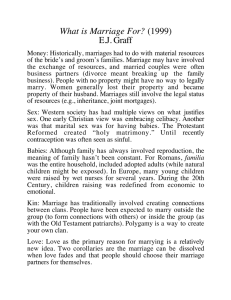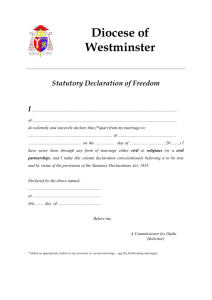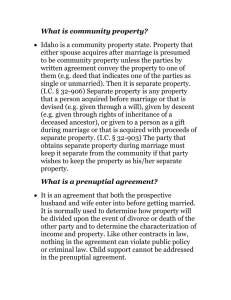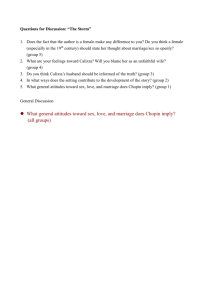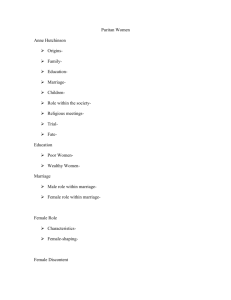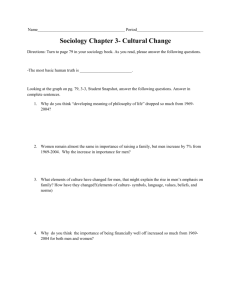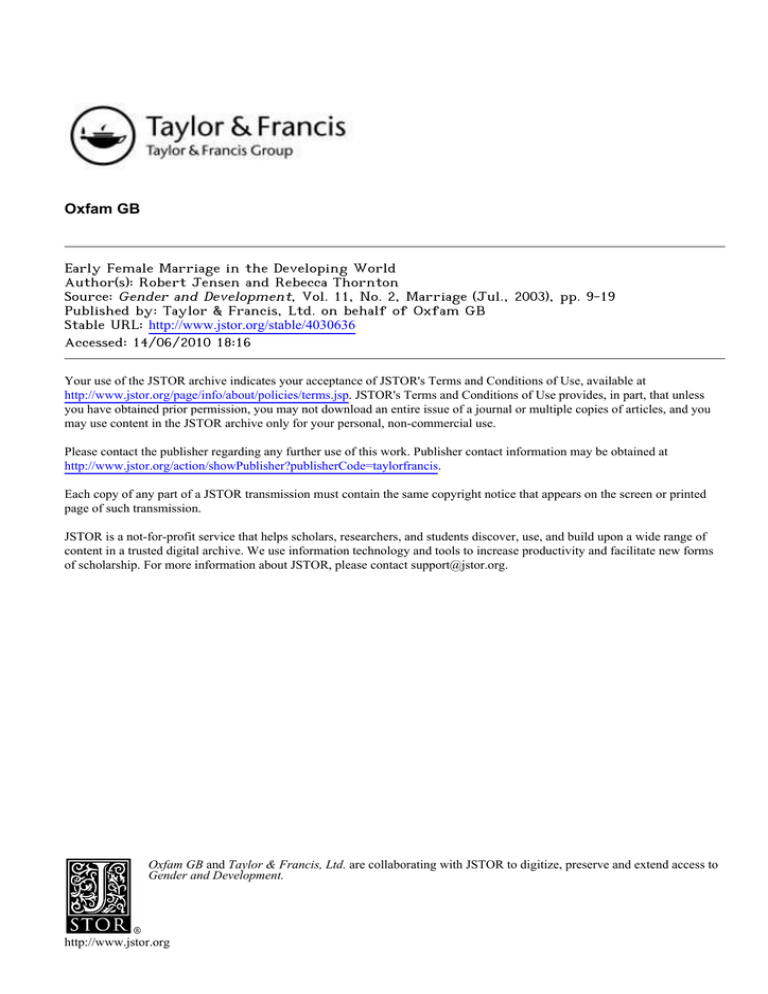
Oxfam GB
Early Female Marriage in the Developing World
Author(s): Robert Jensen and Rebecca Thornton
Source: Gender and Development, Vol. 11, No. 2, Marriage (Jul., 2003), pp. 9-19
Published by: Taylor & Francis, Ltd. on behalf of Oxfam GB
Stable URL: http://www.jstor.org/stable/4030636
Accessed: 14/06/2010 18:16
Your use of the JSTOR archive indicates your acceptance of JSTOR's Terms and Conditions of Use, available at
http://www.jstor.org/page/info/about/policies/terms.jsp. JSTOR's Terms and Conditions of Use provides, in part, that unless
you have obtained prior permission, you may not download an entire issue of a journal or multiple copies of articles, and you
may use content in the JSTOR archive only for your personal, non-commercial use.
Please contact the publisher regarding any further use of this work. Publisher contact information may be obtained at
http://www.jstor.org/action/showPublisher?publisherCode=taylorfrancis.
Each copy of any part of a JSTOR transmission must contain the same copyright notice that appears on the screen or printed
page of such transmission.
JSTOR is a not-for-profit service that helps scholars, researchers, and students discover, use, and build upon a wide range of
content in a trusted digital archive. We use information technology and tools to increase productivity and facilitate new forms
of scholarship. For more information about JSTOR, please contact support@jstor.org.
Oxfam GB and Taylor & Francis, Ltd. are collaborating with JSTOR to digitize, preserve and extend access to
Gender and Development.
http://www.jstor.org
9
Early
the
female
marriage
developing
in
world
Robert Jensen and Rebecca Thornton
Many womenin thedevelopingworldaresubjectto marriageat an earlyage.Most such women
havelittle choicein theage at whichtheymarry,or whomtheymarry.In this article,we examine
patternsand trendsof earlymarriagein thedevelopingworld.Theincidencevarieswidely,from a
highof 70 per cent in south Asia to a low of 30 per cent in SouthEastAsia. Womenwho marry
young tend to haveless educationand beginchildrearingearlier,and haveless decision-making
powerin thehousehold.Theyarealso morelikelyto experiencedomesticviolence.
In most societies,marriageis among the
most significant of life events for both
men and women, signalling the
emergence to adulthood. It sets in motion a
variety of other life changes, and is the
beginning of building a new family (or new
part of an extended family). Because of the
huge impact marriage has on the lives of
women in particular,researchers, advocates
and policy makers have increasingly sought
to consider marriage through a human rights
framework, especially with regard to issues
of consent and age at marriage. For example,
Article 16 of the Universal Declaration of
Human Rights states that 'Marriageshall be
entered into only with the free and full
consent of the intending spouses', and that
'Men and women of full age...are entitled
to equal rights as to marriage...'.
Correspondingly, the United Nations' 1962
Convention on the 'Consent to Marriage,
Minimum Age for Marriage and Registration and an Associated Recommendation'
calls on memberstates to establisha minimum
age of marriage of no less than 15 years.
The 1979 Convention on the 'Elimination of
Against Women',
All Formsof Discrimnination
and the 1990 'African Charter on the Rights
and Welfare of the Child' suggest a
minimum age for marriage of 18 years,
consistent with the definition of childhood
articulated in the 'Convention on the Rights
of the Child'.
Yet despite these various resolutions,
corresponding national laws, and the efforts
of various national and international organisations, many young women (and to a lesser
extent, men) in the developing world are still
subject to early marriage.Often, these young
women have little choice over the age at
which they marry, much less the partner
they marry,because the marriageis typically
arranged or orchestrated by the parents.
Thus, the issues of early marriage and
consent are often intertwined; in fact, in most
societies, no contractof any type entered into
by a minor is legally binding, since young
persons are less capable of understanding
the implications of long-term decisions and
do not have the full autonomy and
Genderand DevelopmentVol. 11, No. 2, July 2003
10
GenderandDevelopment
independence or the mental and emotional
maturity required for such decision-making.
Therefore, early marriages, even when they
occur with the seeming consent of the child,
violate the basic rights of the child, since by
legal definition a child cannot give consent.
Early marriages are also a cause of
concern because of the potential adverse
consequences for women's physical, mental
and emotional development and well-being.
First, early marriage is often associated with
early age at first childbirth, often before
physical growth and development is
complete. Many studies have shown that
early childbirth can have adverse health
consequences for both woman and child
(Senderowitz 1995). Second, marriage is
typically a barrierto education, since women
are often expected to leave school in order to
devote their time to the care of their new
home or to childbearing and childcare.
Finally, the relationship between husband
and wife may be influenced by the age of the
woman at time of marriage, as well as the
husband-wife age gap. In particular,women
who marry young and who marry much
older men may be less capable of asserting
themselves and establishing their position in
the household. As a result, they may have
less power, status, agency and autonomy
within the household. In fact, men may
choose younger brides for this very reason.
The goal of this article is to undertake an
empirical examination of the patterns and
trends in age at marriage in the developing
world and the conditions and well-being of
women who marry young. Of course, early
marriage is an issue of concern for boys as
well as girls. However, we will focus on girls
both because the phenomenon is not as
widespread among boys, and because many
of the consequences, such as the physical
dangers associated with early childbirth, or
status and power in the household, are
specific to girls.
Patterns of age at marriage
To explore the patterns of age at marriage in
the developing world, this article uses data
from the Demographic and Health Surveys
(DHS), a series of representative surveys of
women aged 15-49 conducted in a variety of
countries over the past few decades.' These
surveys are particularly valuable for the
present paper, because they gather data on
marital history, as well as education, fertility
and other factors which may be affected by
early marriage.We restricted our analyses to
women in the samples aged 25 and older,
since by this age all but a very small
percentage of women are, or have been,
married.We also disaggregated the data into
birth cohorts, in order to examine trends
over time. In particular, we focused on the
marriage patterns of women born in the
intervals 1950-54, 1955-59, 1960-64, and
1965-69.2It is beyond the scope of this paper
to attempt to explain why such differences
may exist across societies; our goal in this
section was modest, namely just to describe
the patterns and trends, in order to
demonstrate the nature of the problem, and
pinpoint where the greatest problems exist.
In Figure 1, we present data on the
patterns and trends in age at first marriage in
major regions of the developing world. The
underlying data, from 35 individual
countries surveyed since 1995, are provided
in the appendix.
Looking first at panel A, the average age
at first marriage ranges from a low of about
16 years in South Asia, to a high of about 20
in South East Asia, with all other regions
falling in between. These figures are all well
below the average age at marriage for higher
income countries; according to the UN
World MarriageTables 2000, the average age
at first marriage for women is 26.2 in
Western Europe, 26.9 in Northern Europe,
and 28.1 in North America (UN,
http:/ /unstats.un.org / unsd / demographic
/ww2000/ table2a.htm).
Earlyfemalemarriagein thedevelopingworld
Figure1: Trendsin age at marriageand earlymarriage
A Age atfirst marriage
21Southeast
20--
LatinAmerica
_
19
,
it
NearEastNorthAfrica W t Africa
Ageof
marriage 18
1
-
17.~.-...
.
~
.
-
.
Sub-SaharanAfrica
....
.......!
16
SouthAsia
16 ]
15
1950-1954
1955-1959
1960-1964
1965-1970
Yearof birth
B Married18 or younger
80 SouthA7
70 ------__-----T----Sub-Sahan Africa
.
%Married
6018or
under
-.
WestAfrica
.
50 _NearEast/NorthAfrica
40
-rn
30 20
7
LatinAmerica
So'utt Asia
I
I,
1960-1964
1955-1959
1950-1954
Yearof birth
1965-1970
11
12
GenderandDevelopment
However, even within these regions,
there is a great deal of diversity, as seen in
the appendix table, 'Trend of age at first
marriage'. For example, from 1950 to 1970,
within West Africa, the average age at
marriage is as low as 15 years in Niger, and
as high as 19 years in Ghana. Five countries,
all in Latin America, have average ages of 20
or above (Bolivia, Brazil, Colombia and
Peru). At the other end of the spectrum, in
Bangladesh the average is only about 14.
Panel A of Figure 1 also shows that there
has been little overall change in average age
at marriage for most of the regions. The
notable exceptions are the Near East and
North Africa, where the average age of
marriage has increased by about a year over
the two decades spanned by the data, and
Latin America, where it has decreased by
about a year. The data for the individual
countries in the appendix confirm these
findings, but also show many exceptions.
For example, while most countries in West
Africa show almost no change in age at
marriage over this period, the average age
has declined by about a year in Ghana
and 0.75 years in Nigeria. Five countries
(Ethiopia,Tanzania, Bangladesh, Egypt, and
Turkey) experienced increases in age at
marriage of a year or more, over the two
decades. By contrast, Ghana, Mozambique,
Guatemalaand Nicaraguahave all experienced
declines in age at marriage of about one
year, with Bolivia and Brazil experiencing
declines of nearly a year and a half.
Panel B shows the patterns and trends in
the incidence of early marriage, which we
define here as marriage before age 18, to be
consistent with international conventions.
As a region, the highest incidence of early
marriage is found in South Asia, where
70-75 per cent of women are married by age
18. This is followed by West Africa and subSaharan Africa, with an incidence of 50-60
per cent, and then the Near East and North
Africa, Latin America and South East Asia.
However, even among the lowest groups,
the rate is still very high, with 30 to 40 per
cent of women marrying before the age of 18.
Like the average age at marriage, over the
two decades spanned by the data, the
incidence of early marriage was largely
unchanged for all regions other than the
Near Eastand North Africa,where both Egypt
and Turkey have seen large declines in the
incidence of early marriage and increases in
age at marriage.
But as before, the data on individual
countries show significant variation within
regions. For example, the incidence of early
marriage has decreased by 8-12 percentage
points or more in six countries (Cameroon,
Kenya, Zambia, Zimbabwe, Indonesia and
Egypt), and by about 15 percentage points in
four countries (Ethiopia, Tanzania, the
Dominican Republic, and Turkey). By
contrast, the incidence of early marriage has
increased significantly in far fewer countries,
with only Bolivia and Brazil having
increases of 8 percentage points or more.
There have also been several cases of
extremely sharp declines in the incidence of
early marriage, such as Cameroon (women
born 1950-54 versus those born 1955-59),
Guinea (1955-59 vs. 1960-64), Ethiopia
(1960-64 vs. 65-70), Kenya (1955-59 vs.
1960-64), Tanzania (1955-59 vs. 1960-64),
Zimbabwe (1960-64 vs. 1965-70), the
Dominican Republic (1950-54 vs. 1955-59)
and Turkey (1960-64 vs. 1965-70).
Well-being and condition
of women in early
marriages
As stated earlier, early marriage can
adversely affect women along several
dimensions, such as early termination of
education and onset of childbearing, and
women's status and position within the
household. To explore these issues further,
we focus on four countries in detail, chosen
because the surveys from these countries
contain useful measures of women's status
and well-being. These are Benin, Colombia,
India, and Turkey.
Earlyfemalemarriagein thedevelopingworld
Table1: Well-beingand age of marriagein selectedcountries1
Age of Marriage
<=15
16 - 20
21- 25
0.6
3.2
1.1
2.7
0.5
2.9
0.8
2.8
0.8
3.5
1.8
3.2
1.4
4.0
3.2
3.5
2.4
4.1
3.9
3.5
2.3
4.0
3.5
3.2
16.7
17.3
17.5
17.6
15.7
16.2
16.7
16.8
19.1
19.4
19.6
19.7
23.0
23.3
23.9
24.0
26.4
27.0
28.2
28.3
26.8
30.1
32.7
32.6
11.0
5.7
6.8
6.2
11.6
6.0
7.3
7.3
9.9
5.0
6.0
4.7
7.9
3.7
4.7
2.9
7.1
1.9
4.2
2.1
4.9
1.6
4.4
2.8
<18
Yearsof Education
Benin
Colombia
India
Turkey
Age of FirstBirth
Benin
Colombia
India
Turkey
26 - 30
30+
Husband - Wife Age Gap
Benin
Colombia
India
Turkey
1 Thissample refersto ever-married
womenoverthe age of 25 sampled bythe DHSforwhomwe have
data on the age of marriage.
Table 1 shows that there is a strong
correlation between a woman's age at
marriage and the amount of education that
she receives. Uniformly across the countries,
early marriage is associated with lower
educational attainment. For example, Indian
women who marry before the age of 15
receive less than one year of education, on
average, and women marrying between the
ages of 16 and 20 receive just under two
years. By contrast, Indian women whose
marriage is delayed until after age 21 receive
three to four years of education. Since
marriage and schooling appear incompatible, early marriage is likely to be a
significant barrier to women's education.
By contrast, increasing the demand for
female education may contribute to delayed
age at marriage for women.
The table also shows a relationship
between early marriage and the onset of
childbearing. Across the four countries, on
average, women who marry before age 15
have their first birth between the ages of 15
and 17. This is, on average, three years less
than among women for whom marriage is
delayed until age 15 to 20, and seven years
less than those who marry between the ages
of 21 and 25. The relationship is fairly
continuous, with women who marry at later
ages having much later ages at first birth,
especially because social norms in most
societies emphasise the importance of childbirth taking place only within marriage.
Because of a lower awareness of health
knowledge, and because physical growth
and development are not completed until
later teenage years, women who bear
children at early ages face a much higher risk
of maternal health problems, disability and
death, in addition to risking problems for
their children.
The table also reveals that women who
marry younger are also more likely to marry
much older men, as indicated by the
husband-wife age gap. The pattern is most
13
14
GenderandDevelopment
striking in Benin, where women who marry
under the age of 15 marry men who are on
average 11.1 years older than them. In
contrast, women who delay marriage until
after they are 30 have an average
husband-wife age gap of 4.9 years. The
other countries show a similar pattern of a
declining husband-wife age gap, as
women's age at marriage increases.
These age differences between husband
and wife can affect the power, status and
autonomy of women within the household.
Older men, or their mothers and families,
may be able to manipulate or exert control
over younger women to a greater extent
than in marriages with no such age
difference,because women are less mentally,
emotionally and physically mature, and/or
capable of asserting themselves. Behaviour,
attitudes and power relations that are
formed early in a marriage may persist over
time, especially as regards a woman's status
and position in the household. For these
reasons, autonomy and status of women
may be affected by women's age at marriage
and the husband-wife age gap.
There are obviously many dimensions to
power, status and agency. Even defining
such complex concepts, much less
measuring them, is difficult. However,
for the purposes of analysis, the selected
DHS surveys provide several useful
indicators, although the exact questions
varied across the surveys. In particular, in
India, regarding autonomy and independence, women were asked whether they
needed permission to go to market or to visit
relatives or friends, and whether they were
allowed to have money set aside. They were
also asked whether physical violence by the
husband towards them can be justified in
various instances, including: if the wife is
unfaithful, if her family does not give
money, if she shows disrespect, if she goes
out without telling him, if she neglects the
house or children, or if she does not cook
properly. These questions indicate the
woman's view regarding her status, and
especially her status in relation to men.
As in the India survey, women in Benin
were asked whether physical violence
towards them is justified in various
situations, such as if a woman neglects the
children, if she goes out without telling her
husband, if she argues with him, if she
refuses to have sex with him, or if she burns
the food.
In Colombia, questions regarding
women's status included whether the
respondent'shusband accuses her of unfaithfulness, does not permit her to meet her
girlfriends, tries to limit her contact with
family, insists on knowing where she is, or
doesn't trust her with money. Additionally,
women were asked whether their husband
threatened leaving, taking the children
away, or withdrawing economic support, or
whether she had ever been physically or
sexually abused.
In the Turkey survey, women were also
asked whether men are justified in beating
their wife in a variety of circumstances, in
addition to a variety of questions relating to
whether they believe that women are or
should be subordinate to men. In particular,
they were asked whether they believe that
important household decisions should be
made by men, whether men are wiser,
whether women should not argue with men,
and whether it is better for a male child than
a female child to have education.
Table 2 provides data on the relationship
between these measures of status, and
women's age at marriage. In India, 70 per
cent of women who marry under the age of
15 need permission from their husbands to
go to market, or to visit family or friends.
The rate is much lower, though still very
high, among those marrying at later ages,
with about half of women who marry at age
26 or above needing permission. Similarly,
43 per cent of women marrying before the
age of 15, and 35 per cent of those marrying
before 20, are not allowed to keep money,
compared to only 21-25 per cent of those
who delay marriage until they are 21 or
older. For both measures, there is a clear
gradient between age at marriage and
Earlyfemale marriagein the developingworld
Table2: Status of women:theeffectsof age at marriage'
<18
<=15
16 - 20
21 - 25
26 - 30
30+
Benin2
Beating ever justified
0.66
0.67
0.65
0.57
0.42
0.36
Colombia3
Husband doesn't trust
Threatened
Emotionally abused
Physically abused
Sexual violence
0.34
0.23
0.41
0.18
0.14
0.35
0.25
0.43
0.20
0.17
0.31
0.22
0.39
0.16
0.13
0.26
0.18
0.34
0.12
0.11
0.23
0.13
0.29
0.08
0.07
0.21
0.14
0.28
0.07
0.05
India4
Beaten in past year
Need permission
Beating ever justified
Not allowed money
0.12
0.69
0.59
0.39
0.12
0.70
0.62
0.43
0.10
0.65
0.52
0.35
0.05
0.57
0.44
0.25
0.04
0.53
0.40
0.21
0.04
0.53
0.48
0.24
Beating ever justified
Women subordinate
0.60
0.44
0.64
0.47
0.53
0.37
0.39
0.27
0.36
0.26
0.43
0.24
Turkey5
1 This sample refers to ever-marriedwomen over the age of 25 sampled by the DHS for whom we have
data on the age of marriage.
2 For Benin, 'Beating ever justified' refers to the percentage of women who think it is justified for a
husband to beat his wife in any of the following circumstances: if she neglects the children, if she goes
out without telling her husband, if she argues with him, if she refuses to have sex with him, and if she
burns the food.
3 For Colombia, trust is measured as an average of whether a respondent's husband accuses her of
unfaithfulness, does not permit her to meet her girl friends, tries to limit her contact with family, insists
on knowing where she is, and doesn't trust her with money. 'Threatened' is the average of whether a
respondent's husband threatened leaving her for another women, taking the children from her, or
withdrawingeconomic support. 'Physically abused' is the average of whether a woman's husband had
ever pushed, shaken, or thrown something at her, ever slapped or twisted her arm, or ever hit with fist
or something harmful. 'Sexual violence' refers to whether her husband ever physically enforced sexual
relations when it wasn't wanted.
4 For India, 'permission' is an average of whether the woman needs permission to go to market or to visit
relatives or friends. 'Beating ever justified' is what percentage of women think it is justified for a
husband to beat his wife in any of the following circumstances: if she is unfaithful, if her family does
not give money, if she shows disrespect, if she goes out without telling him, if she neglects house or
children, and if she does not cook properly. Each respondent was also asked whether she was allowed
to have money set aside.
5 For Turkey, 'Beating ever justified' is what percentage of women think it is justified for a husband to
beat his wife in any of the following circumstances: if she burns the food, neglects child care, argues
with her husband, talks to other men, spends needlessly, refuses intercourse. 'Women are
subordinate' is the average of whether she thinks that the important decisions should be made by
men, whether men are wiser, women should not argue with men, and it is better for a male child than a
female child to have education.
15
16
GenderandDevelopment
power or autonomy, with women marrying
earlier faring much worse than those for
whom marriage is delayed.
As stated earlier, in India, Benin and
Turkey, questions were asked regarding
whether a husband is ever justified in
beating his wife under various circumstances. To interpret the results, we created
an indicator that equals one if the female
respondent reports that a husband is
justified in beating his wife under any of the
particular conditions asked, and zero
otherwise. Despite the fact that the specific
circumstances mentioned varied across the
surveys, the levels and patterns across the
three are similar. Of the women who were
married before age 15, 67 per cent of women
in Benin, 62 per cent of women in India, and
64 per cent of women in Turkey believed
that physical abuse from a husband may
be justified under certain circumstances.
By contrast, among women who marry
between the ages of 26 and 30, only 42 per
cent in Benin, 40 per cent in India, and 36 per
cent in Turkey believed such violence may
ever be justified. Some of these views both
reflect, and can be explained by, women's
own view of the position and status of
women. For Turkey, the measure of whether
respondents believed that women should be
subordinate to men is an average of answers
to the questions mentioned above (if
important household decisions should be
made by men, if men are wiser, if women
should not argue with men and whether it is
more important to give education to boys
than girls). Overall, 47 per cent of women
who marry before age 15 agreed with these
statements, compared to only 24 per cent
among those marrying after 30. This is
evidence that younger women may be more
impressionable and easier to control than
those who marry at older ages.
In addition to power or autonomy, the
data for India show that age at marriage is
also correlatedwith physical security. About
12 per cent of women who married at age 15
or younger say their husband has beaten
them in the past year. This is more than twice
the rate among women who married
between ages 21 and 25, and three times the
rate among women who married after the
age of 25. The survey for Colombia also asks
explicitly about the incidence of physical,
emotional, and sexual abuse. Of women
who married early, 25 per cent say that they
have in some way been threatened
emotionally by their husbands, in comparison to 13-14 per cent who marry after
the age of 25. There is also a large difference
between women married early and later in
the incidence of physical and sexual abuse.
While 20 per cent of all women who married
under the age of 15 said that they had been
physically abused, delaying marriage until
after the age of 25 reduced the incidence of
reported violence by almost two-thirds.
For almost all these measures, the largest
differences, or the greatest improvements
for women, correlated to delaying marriage
from 15 or younger to after the age of 15, and
especially waiting until after age 20. In fact,
for many measures, there was little
difference between women married at ages
21 to 25 and women who had delayed
marriage until after 25. Of course, for many
measures in these countries, women's status
overall is still very poor, even for women
who marry later, which is a concern in its
own right. However, the results do suggest
that large improvements in women's wellbeing may be achievable with even small
increases in female age at marriage, or
reduction in the incidence of marriage at the
very youngest ages.
Discussion
and conclusion
Our analysis has shown that there remains a
very high incidence of early marriage in the
developing world. Aside from a few notable
exceptions, there is little evidence of
declining trends, and in many cases, the
trends suggest increases in early marriage.
Further, we have shown that women who
marry young have numerous, sharp
disadvantages in terms of education, status
and autonomy, even including physical
Earlyfemalemarriagein thedeveloping
world
safety. In order to address the problem of
early marriage, there needs to be an
integrated approach, involving stakeholders
at the household, community and national
levels.
Legal and institutional reform
At the national level, where laws prohibiting
such marriages do not exist, an important
first step is to enact them. Such laws signal
the importance of the issue, and are a salient
symbol of the recognition of the rights of
women in marriage. However, as evidenced
by the large number of early marriages
in countries where such laws do exist, bans
and minimum age requirements are not
sufficient. In many cases, enforcement of
these laws is weak, both because of a
resistance from local officials due to
prevailing social norms and practices, and
because of practical difficulties in enforcing
them, such as the widespread lack of birth
registration, which makes age verification
impossible. The latter underscores the
importance of developing the capacity of
local and national governments to collect
and store vital statistics records for births
and marriages. Where the former is the
problem, local law enforcement officials
and community leaders need to be sensitised
to the need to enforce these laws, and
to encourage the elimination of early
marriages.
Even where local practices and customs
favour early marriages, they are in general
superseded by national and international
laws and conventions. For example, the
Preamble of the UN Convention on the
Consent to Marriage, Minimum Age for
Marriage and Registration explicitly states
that nations '....should take all appropriate
measures with a view to abolishing such
customs, ancient laws and practices...' that
contradict the dictates of the Convention.
Necessary steps in this regard include
information and awareness programmes
and activities aimed at civic authorities and
community leaders, as well as at the broader
community.
Challengingthe economic and social
rationalesfor early marriage
Beyond bans and minimum age laws, it is
also essential to focus on the underlying
causes of early marriage. In doing so, it is
important to recognise and understand the
incentives, forces and constraints acting on
both the 'supply' side - that is, why
households marry their daughters at a
young age, and the 'demand' side - that is,
why men prefer younger brides. Both sides
may be acting in ways that are 'rational',
given the prevailing economic, social, health
and political environment.
On the supply side, households may
marry their daughters at young ages because
of the high costs of raising children (food,
clothing, education and health care). This is
particularly likely in contexts where fertility
is high, and parents have many children. In
such cases, girls may be viewed as an
economic burden, so parents may prefer to
marry them out of the household at an
earlier age. In addition, national economic
conditions or crises, or individual economic
shocks, such as a bad harvest or the illness or
death of a primary income earner, may also
cause households to marry their daughters
early. The economic pressures for early
marriage may be strengthened where
grandparents or other relatives are left to
care for children orphaned by AIDS. In this
regard, it may even be seen as in the best
interests of the child to marry her into a more
financially stable household. Similarly, in
places where crime and / or violence are
high, including regions in conflict or without
a strong rule of law, parents may view early
marriage as a way to protect young girls
from violence or sexual advances from men.
A vulnerable household, such as a femaleheaded household, or one in which an
elderly grandparent is left to care for a child,
may feel that the child would be better off
and safer if married into another household.
On the demand side, from the perspective
of the groom, younger brides may be
preferred for a number of reasons. First,
women who are younger have longer
17
18
Genderand Development
reproductive lives during which to have
children. In regions where desired fertility is
high, and/ or infant mortality rates or rates
of miscarriage are high, there will be a
stronger demand for younger brides. Men
and their families may also view younger
brides as more desirable because they are
more easily controlled, and less assertive,
because of their lack of physical, mental and
emotional maturity. Younger brides may
therefore be viewed as more 'trainable'.
They may also be better able physically to
perform household activities. Finally,
younger brides are less likely to have had
previous sexual contact, which, due to social
norms and the prevalence of sexually
transmitted diseases, including HIV/AIDS,
may be considered important or essential to
the groom and/ or his family.
The overall incidence of early marriage
is, therefore, influenced by a variety of
factors on both the supply and demand side.
The demand for young brides in and of itself
will not generate significant numbers of
early marriages, unless there is a supply of
young brides available. Similarly, even if all
parents wanted to marry their daughters
young, if there were no demand for young
brides, no early marriages would occur.
Consequently, policy cannot focus on just
one side of this interaction. As the old
dictum states, 'demand begets supply' and
'supply begets demand'. In particular,
where there is strong demand for young
brides, parents who delay the marriage of
their daughters may have to pay a higher
dowry or receive less in bride price, or may
find less attractive marriages are the only
ones possible as the advancing age of their
daughter makes her less marriageable.
These forces pressure them to marry their
daughters young, even if they would prefer
otherwise. Alternatively, if most households
prefer to marry their daughters young, even
those men preferring older brides would
face pressure to marry young brides,
because they may fear that most of the more
'desirable' brides will be married early, or
that they will have to pay a higher bride
price or receive a lower dowry in order to
secure a 'desirable' older bride. Thus, policy
interventions aimed only at one side of the
problem will be less effective, because if
either the demand or supply remain strong,
the forces of the marriage market will
continue to yield a high incidence of early
marriage.
RobertJensen is Associate Professorof Public
Policy and Rebecca Thornton is a graduate
student at the John F. Kennedy School of
Government at Harvard University. Postal
address:JohnF. KennedySchoolof Government,
Harvard University, Cambridge,MA 02138,
USA.
Notes
1 The data and further documentation are
available from www.measuredhs.com.
2 Since many of the women born to
cohorts later than this will not have yet
married at the time of our survey, we are
unable to analyse patterns in their age at
marriage and the incidence of early
marriage.
References
Senderowitz, J. (1995) 'Adolescent health:
reassessing the passage to adulthood',
World Bank Discussion Paper 272,
Washington DC: World Bank
Earlyfemalemarriagein thedevelopingworld
Appendix:Trendof Age at FirstMarriage,By Yearof Birth1
%MarriedUnder18
AverageAge of Marriage
19501954
19651970
19501954
19551959
19601964
19651970
Benin
BurkinaFaso
Cameroon
IvoryCoast
Ghana
Guinea
Mali
Niger
Nigeria
Togo
18.84
17.56
17.05
18.93
19.63
16.79
16.18
15.19
18.29
18.79
195519601959
1964
West Africa
18.84
18.74
17.42
17.66
18.05
17.75
18.78
19.04
18.74
19.29
17.24
16.62
16.37
16.45
14.94
15.23
17.25
17.89
18.62
19.11
18.83
17.67
17.60
18.58
18.82
16.65
16.25
15.48
17.55
18.37
41.51
62.15
64.09
46.15
40.90
69.72
79.64
86.28
50.90
44.85
41.80
63.25
56.41
48.23
37.04
67.72
74.44
88.87
57.32
41.52
43.11
62.72
54.65
44.79
42.52
60.92
74.03
86.76
54.12
40.12
42.62
60.99
55.98
47.47
36.97
70.12
74.71
83.33
54.36
45.55
CentralAfricanRepublic
Chad
Ethiopia
Kenya
Malawi
Mozambique
Tanzania
Uganda
Zambia
Zimbabwe
17.06
16.06
15.97
18.06
18.30
18.37
17.17
17.51
17.42
19.57
Sub-SaharanAfrica
17.91
17.14
16.81
15.99
16.19
16.09
16.37
16.51
16.95
18.76
18.07
18.93
17.69
17.46
17.54
17.55
17.62
17.28
17.73
17.18
18.25
17.41
17.54
17.68
17.50
17.64
17.95
19.74
18.96
19.05
66.01
74.21
74.64
50.84
50.33
52.31
64.54
58.10
59.65
37.47
56.16
74.69
70.46
48.54
58.68
55.81
63.85
59.28
59.91
38.81
59.93
72.43
67.02
39.60
55.39
55.51
55.10
56.47
56.99
39.72
61.64
70.64
58.24
38.69
55.18
57.43
48.98
52.51
51.76
29.04
Bangladesh
India
Nepal
13.23
17.53
16.43
South Asia
13.48
14.27
17.52
17.75
16.68
16.68
14.49
17.71
16.79
92.61
56.64
71.77
91.87
56.35
68.73
85.93
54.38
68.68
85.65
53.89
69.14
Indonesia
Philippines
18.75
21.32
South East Asia
19.02
18.83
21.01
21.46
19.34
20.89
45.35
25.12
42.99
20.00
40.29
21.18
36.18
22.20
Bolivia
Brazil
Colombia
DominicanRep
Peru
Guatemala
Nicaragua
21.31
21.36
20.79
18.59
20.94
19.49
19.18
LatinAmerica
20.72
20.58
20.64
20.30
20.87
20.99
19.03
19.55
20.71
20.39
19.02
18.66
18.46
18.28
19.89
19.59
20.82
18.89
20.15
18.32
18.23
21.98
23.29
29.53
52.14
29.19
39.60
48.08
25.21
24.66
27.13
44.80
29.86
46.17
50.34
28.07
28.21
27.64
39.57
31.31
47.07
50.73
31.03
31.66
23.46
37.63
30.82
45.51
51.84
Egypt
Turkey
18.44
18.42
The NearEast/NorthAfrica
19.23
19.11
19.49
18.76
19.40
19.60
49.39
46.60
43.57
41.37
41.85
36.85
37.03
29.95
1Thissamplerefersto ever-married
womenovertheageof 25 inthe DHSforwhichwe havedataonthe ageof marriage.
19

